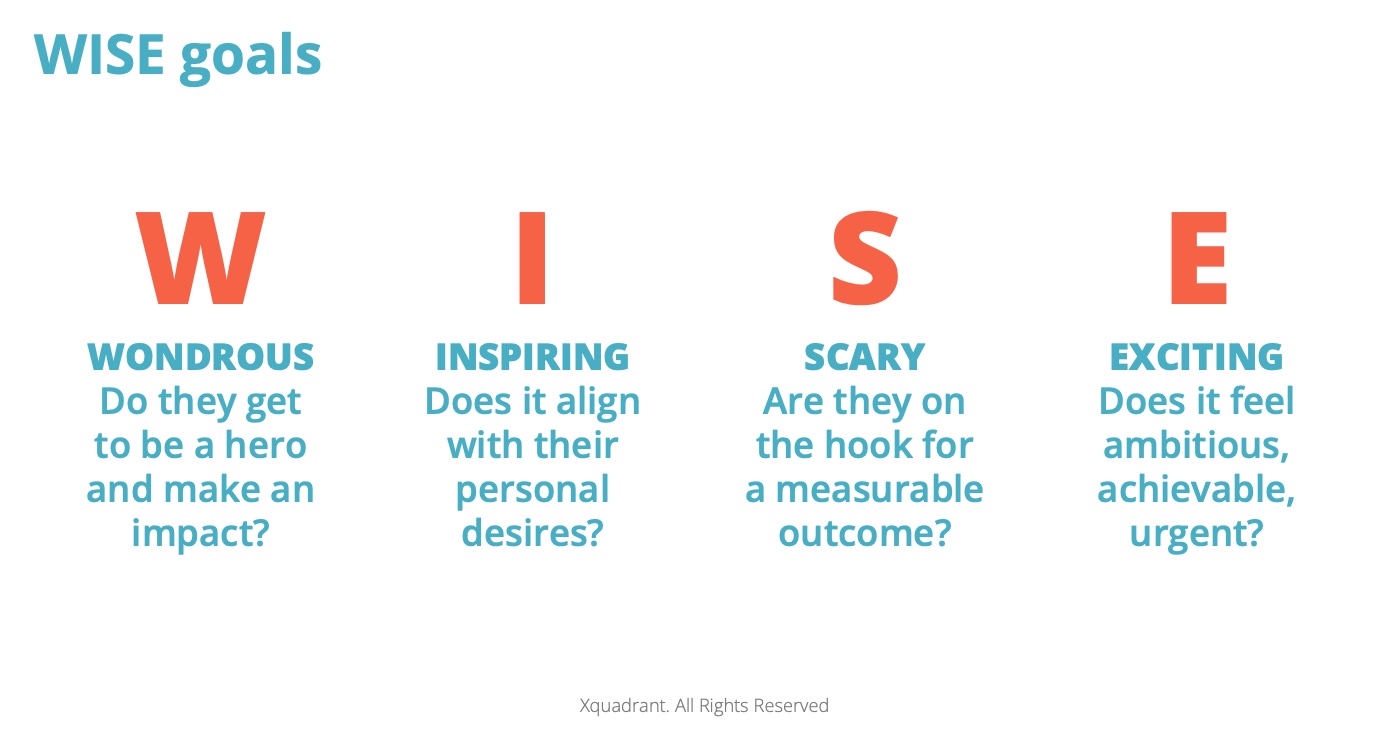If your team isn’t fully engaged and fully owning the projects and areas of responsibility they’ve been assigned, then you’re leaving a lot of value on the table.
Progress will be slow.
Results will be mediocre.
You’ll be repeatedly sucked back into low-level issues to compensate.
The good news is that as a leader you can shape a better environment that draws out the commitment of your team.
In a previous article I talked about the three components of that Ownership Environment.
Part of that is an Inspiring Vision, and today I’m going to offer you a framework to help you co-create goals that do inspire your team and build that sense of ownership.
Your SMART goals aren’t engaging
I’m on the board of a local charitable association. I often hear people grumbling about the ‘lack of commitment’ and ‘lack of volunteers’. Indeed, we can find it hard to get people to sign up for a simple rota. It feels that many people aren’t stepping up and taking ownership for anything.
However, just down the road a theatre company has just mobilised hundreds of people to give up several whole days of their time to volunteer as part of an immersive theatrical experience set in the local castle.
The difference is clear. The charitable association is offering practical but uninspiring “maintenance projects”, and fails to get much engagement, whereas the theatre company painted a very compelling picture of what they wanted to create, and people queued up to put in long hours in support of that.
I wonder if you are operating like that charity, and not like the theatre company. Are you only offering SMART goals (specific, measurable, achievable, realistic, time-bound), like:
- Increase EBITDA by 2M this quarter
- Sign up 30 new clients
- Implement a new appraisal system
But… SMART goals are often boring. They make sense, but they don’t inspire.
- They’re very transactional (increase a metric or deliver a project).
- There’s no sense of being of service to anything apart from the boss’s career or the shareholders’ ROI.
- They don’t have any intrinsic meaning.
- The stakes feel low.
In short, they don’t emotionally resonate. It’s time to create a different sort of goal.
Create WISE goals that inspire ownership
Instead of smart goals, create some WISE goals with your team: outcomes that are Wondrous, Inspiring, Scary and Exciting!

Wondrous
Wondrous goals invite the person to become a hero. They invite the person to see themselves and their daily activity in a new light. And that deeply motivates people.
In 1983, Steve Jobs enticed John Sculley to leave a hugely successful career at PepsiCo to become Apple’s new CEO. Jobs reportedly asked him:
“Do you want to spend the rest of your life selling sugared water, or do you want a chance to change the world?”
Jobs offered Sculley a wondrous goal, a goal that offered the chance to become a hero.
Heroes act on behalf of others. They make a difference in other people’s lives. Make sure your wondrous goals speak to that.
Explain the positive impact the goals will have on your different stakeholders, so your team member can become a hero.
Inspiring
Inspiring goals means that the journey itself is worth taking, from the perspective of the person concerned. But how often are goals crafted with a real understanding of what inspires the people responsible?
As Harry Levinson says in the article “Management by Whose Objectives?”, the typical Management By Objective (MBO) process leaves out the answers to questions including:
- What are the managers’ personal objectives?
- What do they need and want out of their work?
- How are their needs and wants changing?
- What relevance do the organisational objectives have to these desires?
So start to think about what might inspire the different people in your team.
If they love meeting new people - what goals will involve them meeting more and exciting people. If they love coming up with fresh ideas, how can their next project play to that desire? Or, if they love taking on huge goals - how big does the number need to be for them to feel that it’s “game on”?
Ask your team member what most inspires them about what they get to do at work. And craft goals that speak to that.
Scary
There’s a real difference between kicking a ball around with some friends, and playing a match where you’re keeping score. When there’s a real possibility of losing, people step up their game.
If you want your team to really own something, failure needs to be an option, and it needs to matter.
One way to make goals a bit ‘scarier’ is to make sure there’s a meaningful business outcome at stake. I often see leaders asking their team to deliver various initiatives without a discussion about assuming responsibility for any measurable outcomes of the project.
This is what Robert H. Schaffer described as “Colluding with Staff Experts and Consultants” in his HBR article “Four Mistakes Leaders Keep Making”.
For example, how will you know if the new appraisal system, the employee newsletter, the customer survey, or whatever actually delivers meaningful business results?
Stop rewarding “delivery” and start measuring results.
Exciting
You might be giving your teams goals that are too easy, and fail to ignite their creativity. They are too boring to excite.
Or you might be casting a big vision with a huge gap between where you are today and what you want the team to deliver. People are mentally checking out, because the vision seems unattainable and they don’t know where to start. They feel too impossible or too nebulous to excite.
Instead of these two extremes, exciting goals fall in the Goldilocks zone of “ambitious but achievable”. They’re tangible, they require a real stretch, but they don’t feel unrealistic.
One way to make your goals exciting is to come up with an ambitious but achievable 90-day outcome. The finish line is clear; there’s enough time to make a real shift but the deadline is close enough to create some productive urgency.
Create goals that are ambitious, achievable, and have a sense of urgency.
What are your WISE goals?
When I work with my clients on their own breakthrough vision to transform their business and change the world, I spend considerable time working with them to get clear on a mission that’s so big that nothing will stop them.
So, before creating WISE goals for your team - ask yourself, what mission are YOU on that’s wondrous, inspiring, scary and exciting?
- where you get to be a hero (W)
- where the journey itself gets you out of bed (I)
- where the stakes truly matter (S)
- where it feels like an urgent, difficult but winnable game (E)
Get clear about that, because you can’t move others until you’re moved yourself. And then create some WISE goals with your team. Find out what makes them come alive and challenge them to go big.



